Chapter: Compilers : Principles, Techniques, & Tools : Syntax Analysis
Context-Free Grammars
Context-Free Grammars
1 The Formal Definition of a
Context-Free Grammar
2 Notational Conventions
3 Derivations
4 Parse Trees and Derivations
5 Ambiguity
6 Verifying the Language
Generated by a Grammar
7 Context-Free Grammars Versus
Regular Expressions
8 Exercises for Section 4.2
Grammars were introduced in Section 2.2 to systematically describe the
syntax of programming language constructs like expressions and statements.
Using a syntactic variable stmt to
denote statements and variable expr
to denote expressions, the production
stmt —>
if ( expr ) stmt else stmt (4.4)
specifies the structure of this form of conditional statement. Other
productions then define precisely what an expr
is and what else a stmt can be.
This section reviews the definition of a context-free grammar and
introduces terminology for talking about parsing. In particular, the notion of
derivations is very helpful for discussing the order in which productions are
applied during parsing.
1. The Formal Definition of a
Context-Free Grammar
From
Section 2.2, a context-free grammar (grammar for short) consists of terminals,
nonterminals, a start symbol, and productions.
Terminals are the basic symbols from which
strings are formed. The term "token
name" is a synonym for "terminal" and frequently we will use the
word "token" for terminal when it is clear that we are talking
about just the token name. We assume that the terminals are the first
components of the tokens output by the lexical analyzer. In (4.4), the
terminals are the keywords if and else and the symbols "(" and "
) . "
Nonterminals are syntactic variables that
denote sets of strings. In (4.4), stmt and expr are nonterminals. The sets of
strings denoted by nontermi-nals help define the language generated by the
grammar. Nonterminals impose a hierarchical structure on the language that is
key to syntax analysis and translation.
In a grammar, one nonterminal is
distinguished as the start symbol,
and the set of strings it denotes is the language generated by the grammar.
Conventionally, the productions for the start symbol are listed first.
The productions of a grammar
specify the manner in which the termi-nals and nonterminals can be combined to
form strings. Each production
consists of:
A nonterminal called the head or left side of the production; this production defines some of the
strings denoted by the head.
(b) The symbol -K
Sometimes : : = has been used in
place of the arrow.
A body or right side consisting of zero or more terminals and non-terminals.
The components of the body describe one way in which strings of the nonterminal
at the head can be constructed.
Example 4.5 : The grammar in Fig. 4.2 defines simple
arithmetic expressions. In this grammar, the terminal symbols are
i d + - * / ( )
The nonterminal symbols are expression, term and factor, and expression
is the start symbol •
expression -> expression + term
expression -> expression - term
expression -> term
term -> term * factor
term -> term / factor
term -> factor
factor -> ( expression )
factor -> i d
2. Notational Conventions
To avoid always having to state that "these are the
terminals," "these are the nonterminals," and so on, the
following notational conventions for grammars will be used throughout the
remainder of this book.
These symbols are terminals:
Lowercase letters early in the
alphabet, such as a, b, c.
Operator symbols such as +, *,
and so on.
Punctuation symbols such as
parentheses, comma, and so on.
The digits 0 , 1 , . . . ,9 .
Boldface strings such as id or
if, each of which represents a single terminal symbol.
These symbols are nonterminals:
Uppercase letters early in the
alphabet, such as A, B, C.
The letter S, which, when it appears, is usually the start symbol.
Lowercase, italic names such as expr or stmt.
When discussing programming
constructs, uppercase letters may be used to represent nonterminals for the
constructs. For example, non-terminals for expressions, terms, and factors are
often represented by E, T, and F, respectively.
Uppercase letters late in the
alphabet, such as X, 7, Z, represent grammar symbols; that is, either
nonterminals or terminals.
4. Lowercase letters late in the
alphabet, chiefly u,v,..., z, represent (possibly empty) strings of terminals.
5. Lowercase Greek letters, a, 0,
7 for example, represent (possibly empty) strings of grammar symbols. Thus, a
generic production can be written as A ->• a, where A is the head and a the
body.
6. A set of productions A -» ai,
A -»• a2,... , A -> ak with a common head
A (call them A-productions), may
be written A ->• a1 | 0:2 | • • • | 0 ^ . Call
a i , « 2 5 • • • ? c K f c the
alternatives for A.
Unless stated otherwise, the head
of the first production is the start sym-bol.
Exam p l e 4 .6 : Using these
conventions, the grammar of Example 4.5 can be rewritten concisely as

The notational conventions tell
us that E, T, and F are nonterminals, with E the start symbol. The remaining
symbols are terminals. •
3. Derivations
The construction of a parse tree can be made precise by taking a
derivational view, in which productions are treated as rewriting rules.
Beginning with the start symbol, each rewriting step replaces a nonterminal by
the body of one of its productions. This derivational view corresponds to the
top-down construction of a parse tree, but the precision afforded by
derivations will be especially helpful when bottom-up parsing is discussed. As
we shall see, bottom-up parsing is related to a class of derivations known as
"rightmost" derivations, in which the rightmost nonterminal is
rewritten at each step.
For example, consider the following grammar, with a single nonterminal E, which adds a production E ->• — E to the grammar (4.3):
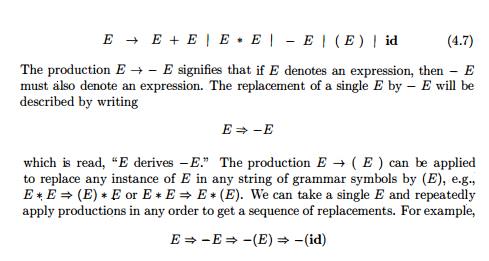
which is read, "E derives
—E." The production E -> ( E ) can be applied to replace any instance
of E in any string of grammar symbols by (E), e.g., E* E (E) *E or E*E=>E*
(E). We can take a single E and repeatedly apply productions in any order to
get a sequence of replacements. For example,
E=>-E=>-(E) => - ( i d )
We call such a sequence of
replacements a derivation of - ( i d ) from E. This derivation provides a proof
that the string - ( i d ) is one particular instance of an expression.
For a general definition of derivation, consider a nonterminal A in the middle of a sequence of grammar symbols, as in aA(3, where . a and (3 are arbitrary strings of grammar symbols. Suppose A ->• 7 is a production. Then, we write aAj3 aj(3. The symbol means, "derives in one step." When a sequence of derivation steps a1 =>• a2 => • • • an rewrites a± to an, we say at derives an. Often, we wish to say, "derives in zero or more steps." For this purpose, we can use the symbol =>•. Thus,
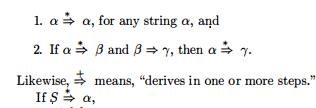
where S is the
start symbol of a grammar G, we say that a is a sentential form of G. Note that
a sentential form may contain both terminals and nonterminals, and may be
empty. A sentence of G is a sentential form with no nonterminals. The language
generated by a grammar is its set of sentences. Thus, a string of terminals w
is in L(G), the language generated by G, if and only if w is a sentence of G
(or S =>• w). A language that can be generated by a grammar is said to be a
context-free language. If two grammars generate the same language, the grammars
are said to be equivalent.
The string - ( i d + id) is a
sentence of grammar (4.7) because there is a derivation

The strings E, -E, -(E),... , -
(id + id) are all sentential forms of this grammar. We write E ^ - ( i d + id)
to indicate that - ( i d + id) can be derived from E.
At each step in a derivation,
there are two choices to be made. We need to choose which nonterminal to
replace, and having made this choice, we must pick a production with that
nonterminal as head. For example, the following alternative derivation of - ( i
d + id) differs from derivation (4.8) in the last two steps:

Each nonterminal is replaced by
the same body in the two derivations, but the order of replacements is
different.
To understand how parsers work,
we shall consider derivations in which the nonterminal to be replaced at each
step is chosen as follows:
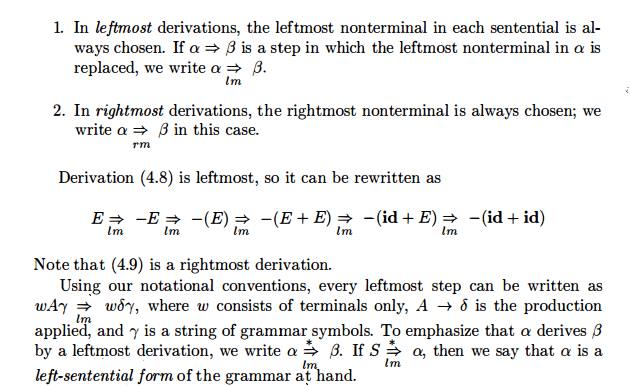
Analogous definitions hold for
rightmost derivations. Rightmost derivations are sometimes called canonical
derivations.
4. Parse Trees and Derivations
A parse tree is a graphical
representation of a derivation that filters out the order in which productions
are applied to replace nonterminals. Each interior node of a parse tree
represents the application of a production. The interior node is labeled with
the nonterminal A in the head of the production; the children of the node are
labeled, from left to right, by the symbols in the body of the production by
which this A was replaced during the derivation.
For example, the parse tree for -
( i d + id) in Fig. 4.3, results from the derivation (4.8) as well as
derivation (4.9).
The leaves of a parse tree are
labeled by nonterminals or terminals and, read from left to right, constitute a
sentential form, called the yield or frontier of the tree.
To see the relationship between
derivations and parse trees, consider any derivation  is a single nonterminal A. For each sentential form at in the derivation, we
can construct a parse tree whose yield is ai. The process is an induction on i.
is a single nonterminal A. For each sentential form at in the derivation, we
can construct a parse tree whose yield is ai. The process is an induction on i.
BASIS: The tree for a1 = A is a
single node labeled A.
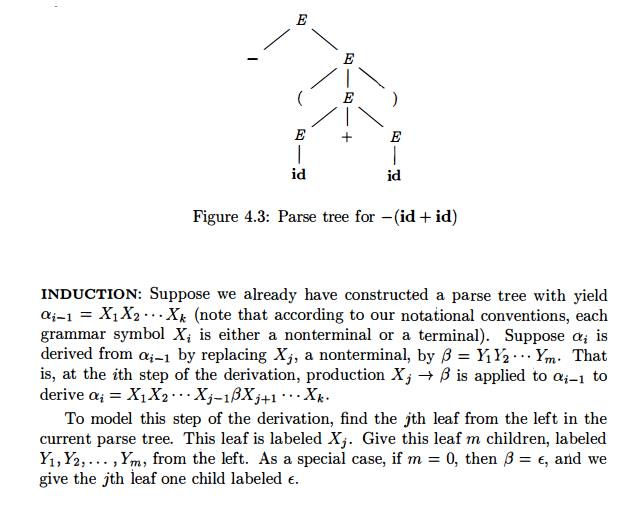
Example 4.10 : The sequence of
parse trees constructed from the derivation (4.8) is shown in Fig. 4.4. In the
first step of the derivation, E -E. To model this step, add two children,
labeled — and E, to the root E of the initial tree. The result is the second
tree.
In the second step of the
derivation, —E =$> -(E).
Consequently, add three children, labeled (j E, and ), to the leaf labeled
E of the second tree, to obtain the
third tree with yield -(E).
Continuing in this fashion we obtain the complete parse tree as the sixth tree.
•
Since a parse tree ignores
variations in the order in which symbols in senten-tial forms are replaced,
there is a many-to-one relationship between derivations and parse trees. For
example, both derivations (4.8) and (4.9), are associated with the same final
parse tree of Fig. 4.4.
In what follows, we shall
frequently parse by producing a leftmost or a rightmost derivation, since there
is a one-to-one relationship between parse trees and either leftmost or
rightmost derivations. Both leftmost and rightmost derivations pick a
particular order for replacing symbols in sentential forms, so they too filter
out variations in the order. It is not hard to show that every parse tree has
associated with it a unique leftmost and a unique rightmost derivation.
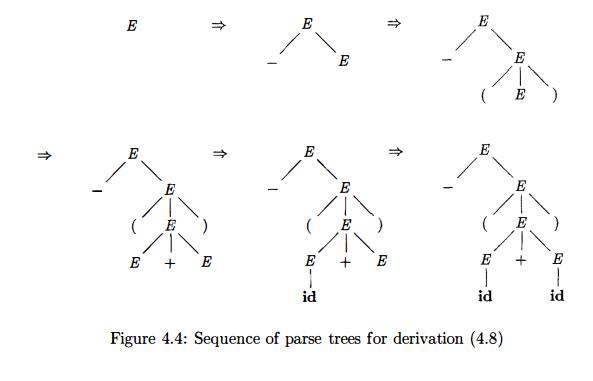
5. Ambiguity
From Section 2.2.4, a grammar that produces more than one parse tree for
some sentence is said to be ambiguous.
P u t another way, an ambiguous grammar is one that produces more than one
leftmost derivation or more than one rightmost derivation for the same
sentence.
E x a m p l e 4 . 1 1 : The
arithmetic expression grammar (4.3) permits two distinct leftmost derivations
for the sentence id + id * id:

The
corresponding parse trees appear in Fig. 4.5.
Note that the parse tree of Fig. 4.5(a) reflects the commonly assumed
prece-dence of + and *, while the tree of Fig. 4.5(b) does not. That is, it is
customary to treat operator * as having higher precedence than +, corresponding
to the fact that we would normally evaluate an expression like a + b * c as a + (b * c), rather than
as (a + b) * c. •
For most parsers, it is desirable that the grammar be made unambiguous,
for if it is not, we cannot uniquely determine which parse tree to select for a
sentence. In other cases, it is convenient to use carefully chosen ambiguous
grammars, together with disambiguating
rules that "throw away" undesirable parse trees, leaving only one
tree for each sentence.
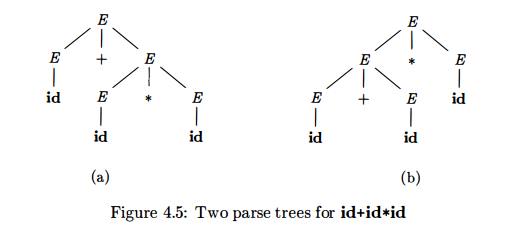
6. Verifying the Language
Generated by a Grammar
Although compiler designers rarely do so for a complete
programming-language grammar, it is useful to be able to reason that a given
set of productions gener-ates a particular language. Troublesome constructs can
be studied by writing a concise, abstract grammar and studying the language
that it generates. We shall construct such a grammar for conditional statements
below.
A proof that a grammar G
generates a language L has two parts:
show that every string generated by G
is in L, and conversely that every
string in L can indeed be generated
by G.
Example 4.12 : Consider the
following grammar:

It may not be initially apparent, but this simple grammar generates all
strings of balanced parentheses, and only such strings. To see why, we shall show
first that every sentence derivable from S
is balanced, and then that every balanced string is derivable from 5. To show
that every sentence derivable from S is
balanced, we use an inductive proof on the number of steps n in a derivation.
BASIS: The basis is n
= 1. The only
string of terminals derivable from S
in one step is the empty string, which surely is balanced.
INDUCTION : Now assume that all derivations of fewer than n steps produce balanced
sentences, and consider a leftmost derivation of exactly n steps. Such a derivation must be of the form

The derivations of x and y from S take fewer than n
steps, so by the inductive hypothesis x
and y are balanced. Therefore, the
string (x)y must be balanced. That
is, it has an equal number of left and right parentheses, and every prefix has
at least as many left parentheses as right.
Having thus shown that any string derivable from S is balanced, we must next show that every balanced string is
derivable from S. To do so, use
induction on the length of a string.
B A S I S: If the
string is of length 0, it must be e, which is balanced.
I N D U C T I O N : First, observe that every balanced string has even length. As-sume that
every balanced string of length less than 2n is derivable from 5, and consider
a balanced string w of length 2n, n > 1. Surely w begins with a left parenthesis. Let (x) be the shortest nonempty prefix of w having an equal number of left and right parentheses. Then w can be written as w = (x)y where both x and
y are balanced. Since x and y are of length less than 2n, they are derivable from S by the inductive hypothesis. Thus, we
can find a derivation of the form

proving that w = (x)y is also
derivable from 5. •
7. Context-Free
Grammars Versus Regular Expressions
Before leaving this section on grammars and their properties, we
establish that grammars are a more powerful notation than regular expressions.
Every con-struct that can be described by a regular expression can be described
by a gram-mar, but not vice-versa. Alternatively, every regular language is a
context-free language, but not vice-versa.
For example, the regular expression (a|b)*abb
and the grammar

describe
the same language, the set of strings of a's and 6's ending in abb.
We can construct mechanically a grammar to recognize the same language
as a nondeterministic finite automaton (NFA). The grammar above was
con-structed from the NFA in Fig. 3.24 using the following construction:
1. For
each state i of the NFA, create a
nonterminal Ai.
If state i has a transition to state j
on input a, add the production Ai —>
aAj. If state i goes to state j on
input e, add the production Ai —• Aj.
Hi is an accepting state, add Ai —> e.
If i is the start state, make Ai be the start symbol of the grammar.
On the other hand, the language L = {anbn | n >= 1}with an equal number of a's and 6's is a prototypical example of a language that can be described by a grammar but not by a regular expression. To see why, suppose L were the language defined by some regular expression. We could construct a DFA D with a finite number of states, say k, to accept L. Since D has only k states, for an input beginning with more than k a's, D must enter some state twice, say Si, as in Fig. 4.6. Suppose that the path from Si back to itself is labeled with a sequence aibi Since a1 bl is in the language, there must be a path labeled bl from Si to an accepting state /. But, then there is also a path from the initial state «o through to / labeled aibi, as shown in Fig. 4.6. Thus, D also accepts aibi, which is not in the language, contradicting the assumption that L is the language accepted by D.
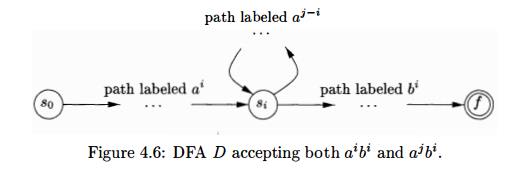
Colloquially, we say that "finite automata cannot count,"
meaning that a finite automaton cannot accept a language like {anbn1n > 1}
that would require it to keep count of the number of a's before it sees the
6's. Likewise, "a grammar can count two items but not three," as we
shall see when we consider non-context-free language constructs in Section
4.3.5.
8. Exercises for Section 4.2
Exercis 4 . 2 . 1 : Consider the context-free
grammar:

and the
string aa + a*.
Give a leftmost derivation for
the string.
Give a rightmost derivation for
the string.
Give a parse tree for the string.
! d) Is the grammar ambiguous or unambiguous? Justify your answer.
! e) Describe the language generated by this grammar.
Exercise 4 . 2 . 2 : Repeat Exercise 4.2.1 for each
of the following grammars and strings:
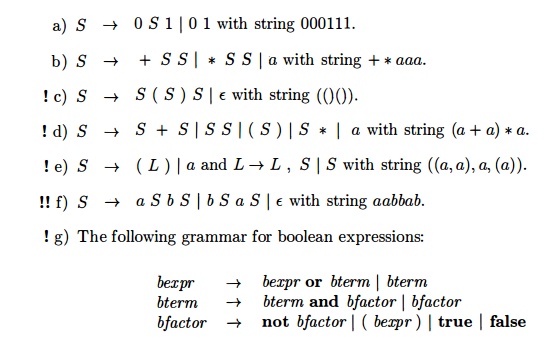
Exercise 4 . 2 . 3 : Design
grammars for the following languages:
a) The
set of all strings of 0s and Is such that every 0 is immediately followed by at
least one 1.
! b) The
set of all strings of 0s and Is that are palindromes;
that is, the string reads the same backward as forward.
! c) The set of all strings of 0s and Is with an
equal number of 0s and Is.
!! d) The set of all strings of 0s and Is with an unequal number of 0s and Is.
! e) The
set of all strings of 0s and Is in which Oil does not appear as a substring.
!! f) The
set of all strings of 0s and Is of the form xy,
where x ^ y and x and y are of the same
length.
Exercise 4 . 2 . 4 : There is an extended grammar notation in common use. In this notation, square and curly braces
in production bodies are metasymbols (like —>• or |) with the following
meanings:
i) Square
braces around a grammar symbol or symbols denotes that these constructs are
optional. Thus, production A —> X [Y] Z has the same effect as the two
productions A X Y Z and A -± X Z.
ii) Curly
braces around a grammar symbol or symbols says that these symbols may be
repeated any number of times, including zero times. Thus,
A —>• X {Y Z} has the same effect as the
infinite sequence of productions A-*X,A->XYZ,A-*XYZYZ, and so on.
Show that
these two extensions do not add power to grammars; that is, any language that
can be generated by a grammar with these extensions can be generated by a
grammar without the extensions.
Exercise
4.2.5 : Use the braces described in
Exercise 4.2.4 to simplify the following
grammar for statement blocks and conditional statements:

Exercise 4 . 2 . 6 : Extend the idea of Exercise
4.2.4 to allow any regular expres-sion of grammar symbols in the body of a
production. Show that this extension does not allow grammars to define any new
languages.
Exercise 4 . 2 . 7: A grammar symbol X
(terminal or nonterminal) is useless if there is no derivation of the form S wXy ^ wxy. That
is, X can never
appear in the derivation of any sentence.
Give an algorithm to eliminate
from a grammar all productions containing useless symbols.
Apply your algorithm to the
grammar:

Exercise 4 . 2 . 8: The
grammar in Fig. 4.7 generates declarations for a single
numerical identifier; these declarations involve four different, independent
properties of numbers.
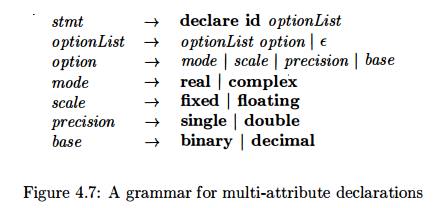
Figure
4.7: A grammar for multi-attribute
declarations
a) Generalize the grammar of Fig. 4.7 by allowing n options Ai, for some fixed n and for i = 1,2 ... ,n, where Ai can be either ai or bi. Your grammar
should use only 0(n) grammar symbols
and have a total length of productions that is 0(n).
! b) The
grammar of Fig. 4.7 and its generalization in part (a) allow declara-tions that
are contradictory and/or redundant, such as:
declare
foo real fixed real floating
We could insist
that the syntax of the language forbid such declarations; that is, every
declaration generated by the grammar has exactly one value for each of the n
options. If we do, then for any fixed n there is only a finite number of legal
declarations. The language of legal declarations thus has a grammar (and also a
regular expression), as any finite language does. The obvious grammar, in which
the start symbol has a production for every legal declaration has n!
productions and a total production length of 0 ( n x n!). You must do better: a
total production length that is 0 ( n 2 n ) .
!! c)
Show that any grammar for part (b) must have a total production length of at
least 2 n .
d) What
does part (c) say about the feasibility of enforcing nonredundancy and noncontradiction
among options in declarations via the syntax of the programming language?
Related Topics